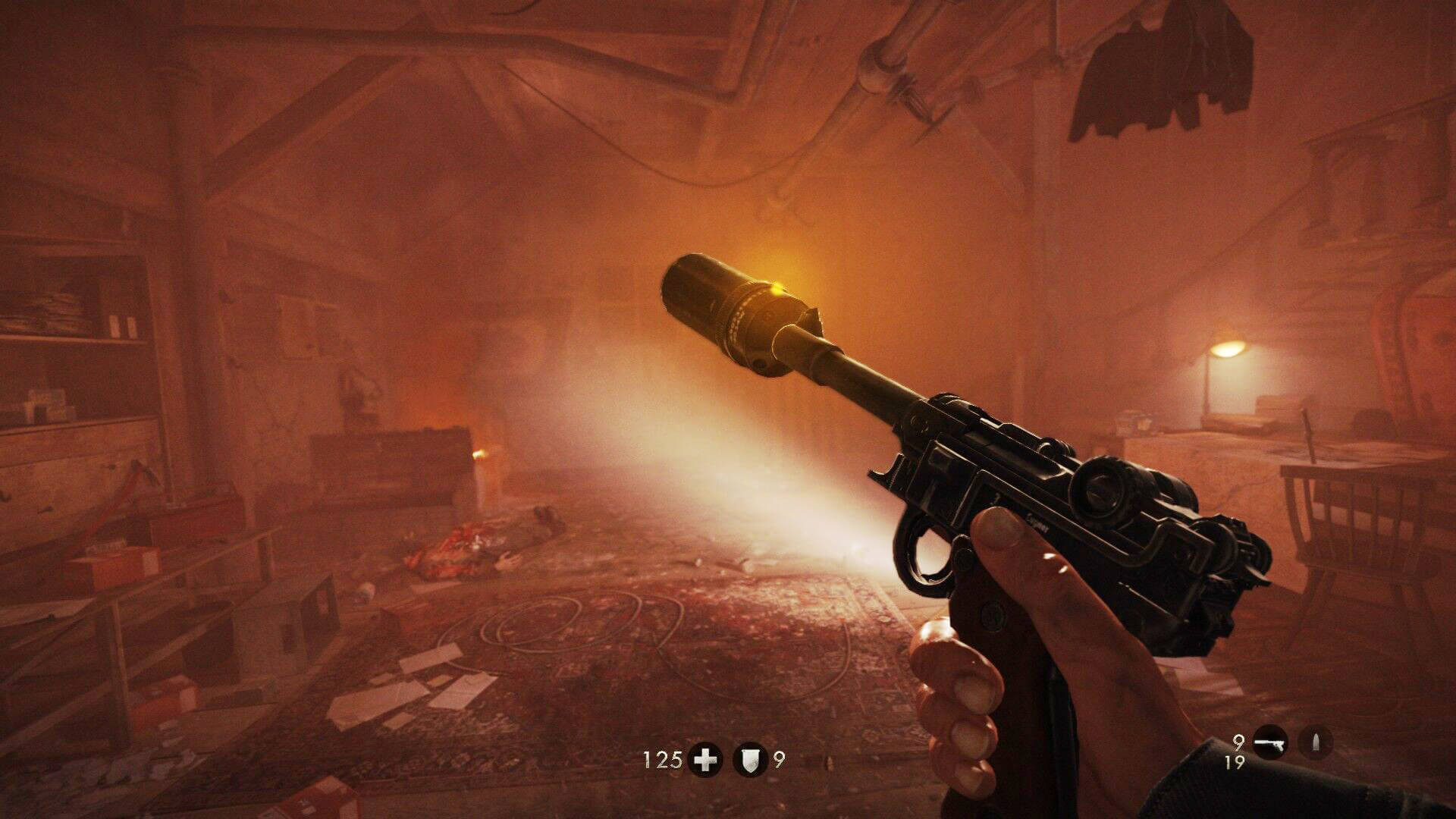 If you've played video games, you've encountered a handgun. In the right game, a handgun can be an object of menace or empowerment. But video games often treat them as a starter weapon to be replaced as soon as possible. What makes for a great video game handgun?
If you've played video games, you've encountered a handgun. In the right game, a handgun can be an object of menace or empowerment. But video games often treat them as a starter weapon to be replaced as soon as possible. What makes for a great video game handgun?
A Brief History Lesson
Handguns are among the oldest type of firearms. Originating in ancient China as small hand cannons, guns eventually evolved into muzzle loaders, like those seen in Assassin's Creed IV: Black Flag, then revolvers, like most of the handguns in Red Dead Redemption, and eventually semi-automatic pistols, like the M1911 from games like Call of Duty and Medal of Honor. Police forces started equipping guns in the 1800s. When World War I came to a close, weapons manufacturers turned to the police to maintain their sales. Firearms and police forces have been closely connected ever since.
Handguns are almost as old as video games themselves. What may have been the first video game handgun appeared in Taito's 1975 Western Gun, a Wild West-themed game where players shot at each other with revolvers. Other early examples of handguns include Nintendo's 1979 Western game Sheriff, Capcom's 1985 vertical side-scroller Gun.Smoke, and Konami's 1991 Sunset Riders. 1981's Castle Wolfenstein, most notable for being the earliest stealth game, begins with a dying prisoner handing the player a gun they stole from the guards. In gameplay, the gun appears to be a handgun of some kind, most likely a Luger pistol. As games grew in sophistication and platforms grew in power, handguns became firmly entrenched in video game design.
How Handguns Work
Whether it's Doom's classic pistol or Bloody Mary's Smith & Wesson Model 29 in The Wolf Among Us, handguns are ubiquitous video games. The appeal is obvious: handguns are small, portable, and easily concealed. When a villain reveals the gun hidden in his coat, it's a moment of surprise. When a gunslinger draws on his opponent and wins the duel, it's thrilling. It's a lot harder to hide a rifle or draw a shotgun quickly.
While there have been a staggering variety of handguns throughout the centuries, the most common types in games are revolvers and pistols, though the term "pistol" is often used synonymously with all handguns.
Handguns start with a round, or cartridge, which consists of a case, the bullet, a primer, and the propellant. The cartridge is inserted into the chamber. Pulling the trigger causes the firing pin to strike the cartridge, which causes the primer to ignite the propellant. The expanding gases from the propellant push the bullet through the barrel of the gun, sending the bullet towards its target.

The difference between a revolver and a pistol is in the way they chamber bullets. A revolver features a cylinder, which is usually loaded with six rounds, though there have been rare, unsuccessful variants over the years with as many as 30 rounds. When you pull the trigger, the cylinder rotates and the hammer pulls back. When you let go, the hammer strikes, firing the round. When you pull again, the cylinder rotates, and so on. Here's a detailed video demonstrating the entire process.
Pistols work differently. Rather than a cylinder, the pistol's rounds are loaded into a magazine, which is usually inserted into the pistol's grip. A round can't be fired until it's chambered, or transferred from the magazine to the chamber. Pull the trigger, fire a round, chamber a new round, pull the trigger again.
If you've played a lot of games, especially shooters, you're probably familiar with the basic pistol archetypes. From Half-Life to Gears of War to Destiny, revolvers are portrayed as slow-firing, powerful weapons, while pistols are portrayed as weaker but faster-firing. This is a myth, because plenty of things can hamper a revolver's power, and in some cases revolvers can fire just as fast as pistols. Power has nothing to do with the way the round is chambered. A round's power is determined largely by its kinetic force, and that force is determined by the round itself, based on the mass of the bullet and the power of the propellant.
So why do shooters perpetuate these myths about how handguns work?
How Handguns Work In Shooters
Most shooter design can be traced, in some way, back to Doom, id's seminal 1993 creation. Doom cemented basic shooter weapon archetypes in video games: the pistol, the shotgun, the automatic rifle, and the rocket launcher. In Doom, the pistol fired a single shot, the shotgun fired multiple pellets at once, the plasma rifle and chaingun fired multiple shots in quick succession, and the rocket launcher fired a single shot that did explosive splash damage.
Developers have been fond of progression systems, and Doom's weapon-based progression was near perfect: start with the pistol, end up with the incredible plasma-firing BFG. In the 24 years since Doom's release, few developers have messed with the formula. Halo tried churn, where players had to constantly scavenge for weapons on the battlefield, and Borderlands went for a Diablo-style stat system. But most shooters all begin the same way: like Doom, they start with a handgun.

As a result, handguns tend to be portrayed as weak starter weapons that you replace with more powerful shotguns or more accurate rifles. Some shooters, like Destiny or Borderlands, are based around stats; as you grow in power, you find guns with better stats, doing, say, 100 damage instead of 50. Others, like Hitman, give pistols the advantage of being concealable or quiet, making them preferable over more aggressive weaponry. But by and large handguns are starter weapons, meant to be suffered through until something better comes along.
Video game weapons rarely match their real-world counterparts. In video games, shotguns tend to shoot confetti beyond three meters, and flamethrowersseem to be propane-based movie flamethrowers, which are designed to keep actors safe rather than behaving like their proper napalm-based counterparts. Handguns are no different: as the starting weapons, they tend to be weak, because they exist as gateway weapons that carry you along until you get to better weapons. But it doesn't have to be this way.
How Breaking The Rules Leads To Better Handguns
Handguns don't need to be weak. Plenty of games contain unique takes on handguns that elevate them from starter weapons into some of the best weapons in shooter history.
Titanfall 2 contains a level where you lose all your weapons, but you gain the smart pistol for the first time shortly after. What follows is a level that's all about empowerment. Every other weapon in the game needs aiming, but the smart pistol locks on and one-shots enemies. This lets you wallrun without sacrificing your accuracy, making for an awesome escape sequence where you never stop running. Getting that pistol, in some ways, feels like the pinnacle of Titanfall 2's campaign.
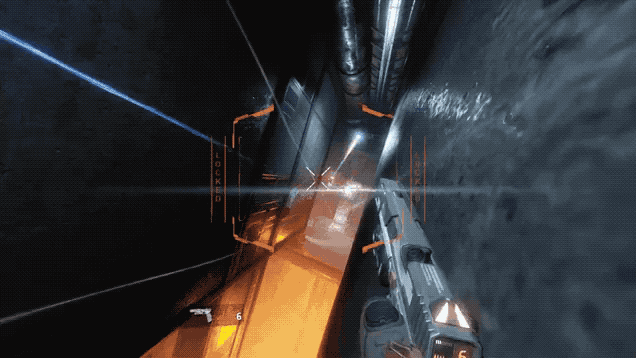
Wolfenstein: The New Order's pistol is no slouch, but it's the only weapon in the game that can be silenced. This makes it a great choice if you're trying to play stealthily. You can also dual-wield and auto-fire, adding to its versatility, but it shines in its unique role as a stealth tool. Since The New Order has plenty of stealth segments, the pistol holds its own.
The Boltok, from the Gears of War series, is a legendary revolver. One of the Gears series best features is its gib system. Most enemies die as you would expect when they're killed, but when the you headshot an enemy with the Boltok, his head practically explodes in a fountain of blood and viscera, accompanied by a satisfying splorch noise. The big secret to Gears special sauce is the way enemies react to its guns, and the Boltok creates some of the best reactions in the series.
Halo: Combat Evolved's M6D seems like a regular pistol, but it's got a nice 2X scope on it, which isn't a common feature on video game pistols. Later Halogames treat pistols more like the traditional weak starter weapon, even when you don't actually start with a pistol, but the M6D has high damage and can hold its own in a firefight. Heck, if you're in the right position, the M6D can take out Halo's toughest enemies, hunters, with a single shot to their weak point. The M6D feels amazing in part because it isn't a hitscan weapon; there's this split second of lag between firing and hitting that gives it a satisfying crunch that hitscan weapons in other games can't replicate.
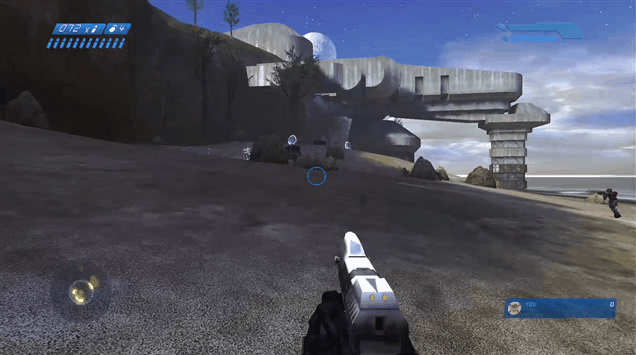
Bungie didn't stop there. Destiny released with an entire suite of revolvers, referred to in-universe as "hand cannons." They pack a punch, one-shotting most enemies with a hit to their critical weak point. I could wax poetic about the gorgeous Hawkmoon, or I could tell you about the hell that was finding Thorn (but Kirk already did that), but Destiny's The Last Word is the Platonic ideal of what a revolver should be. It fires as fast as you can pull the trigger. It's all about firing from the hip. When you switch to it from another weapon, you spin it as you pull it out. You fan the hammer like a gunslinger of old. Everything about its presentation is awe-inspiring, and despite the constant nerfs, it still feels magnificent.
There was a time when one of Destiny's rarest guns, Fatebringer, was also one of its most used. Fatebringer was a legendary hand cannon in Destiny that could only be dropped by the Templar, the first boss in the Vault of Glass raid. People saved the checkpoint and passed it around all their characters, hoping to get a Fatebringer drop. Prior to the field scout perk nerf, its magazine size was a monstrous 13 rounds; you always had bullets. It felt destructive and truly rewarding to find.
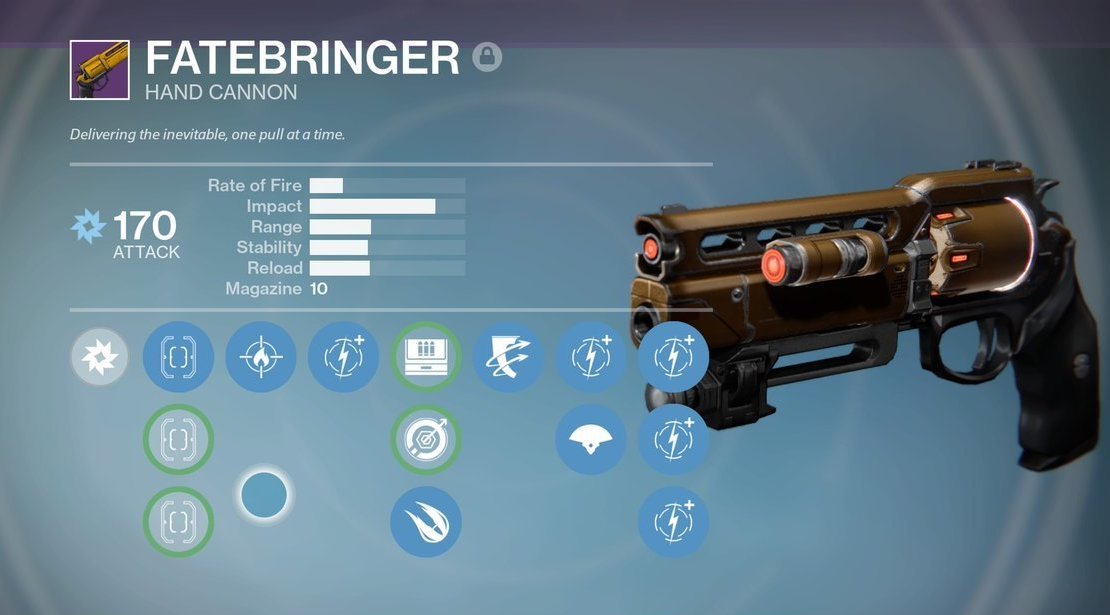
Fatebringer was so desirable because it didn't only have the same great feel as all of Destiny's hand cannons, it also had a mix of perks that make it a showstopping powerhouse. It had an elemental damage type, something most primary weapons didn't have. When you hit someone in the head, they exploded, thanks to a perk called Firefly. Fatebringer was the only hand cannon with the perk. It had another amazing perk called Outlaw, which meant that headshots rewarded the player with a quick reload.
Revolvers tend to make you work for your shots, because you're only firing one bullet at a time. Bulletstorm's designers understood this, and so they developed their revolver the Screamer with two fire modes. The first fire mode is your typical bullet, but the secondary fire mode lets you shoot a rocket that can launch enemies into the air and set nearby enemies on fire. Bulletstorm heavily emphasized its unique skill-shot system to encourage players to try killing enemies in interesting ways, and the Screamer complemented that system perfectly.
In addition to great handguns, many games modify pistols to make them even more interesting. Halo's plasma pistol is another classic. One of the reasons Haloremains just as fresh today as it was in 2001 is because it deviates from traditional shooter tropes. Everyone wanted to make a Halo killer, but most of them failed to create weapons that complemented their enemy designs. The plasma pistol's genius was that it was designed specifically to take out elite and jackal shields.
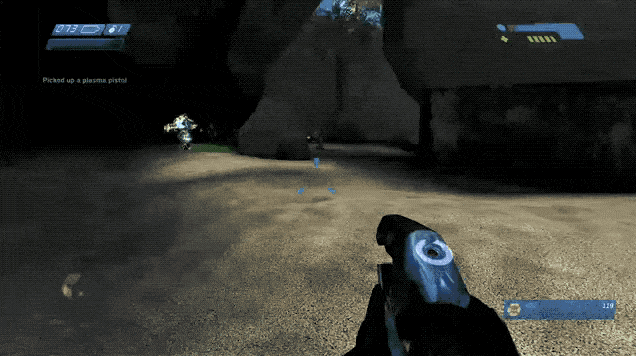
You can fire as fast as you can pull the trigger, or you can hold it down to build up a devastating charge shot. If you hold the trigger too long, the plasma pistol will discharge, damaging you instead. It's a complicated weapons, but in the hands of a skilled player, the lowly plasma pistol is a powerful deterrent to enemy energy shields.
Titanfall 2's smart pistol is great, but you can only use it once in the campaign. Luckily, the game also introduced the best gun in Titanfall 2, the triple-barrel shotgun pistol the Mozambique. The Mozambique rewards aggression and getting right in there to mow down your enemies. No handgun has ever felt quite so explosive.

There are so many more great handguns out there. Max Payne's dual-wielded Berettas are pure joy in bullet time. Enter the Gungeon's pea shooter is a gun that fires actual peas. The Half-Life magnum is a monster, despite its scarce ammo. Resident Evil Revelations' Pale Rider has to be seen to be believed. Payday's Stryk pistol is basically a fully automatic Glock 18 with a gigantic magazine, my favorite bullet hose in gaming. All these handguns are powerful, unique, and anything but starter weapons.
Handguns don't have to be weak. Some of the best, most exciting guns in video games are handguns. Great shooter design relies heavily on guns that push players to act in interesting ways, and guns like Fatebringer and Halo's plasma pistol prove that's possible. A good handgun is versatile and interesting; a great handgun makes you feel like a gunslinger. Ain't nothing quite like slapping leather and letting the bullets fly.
